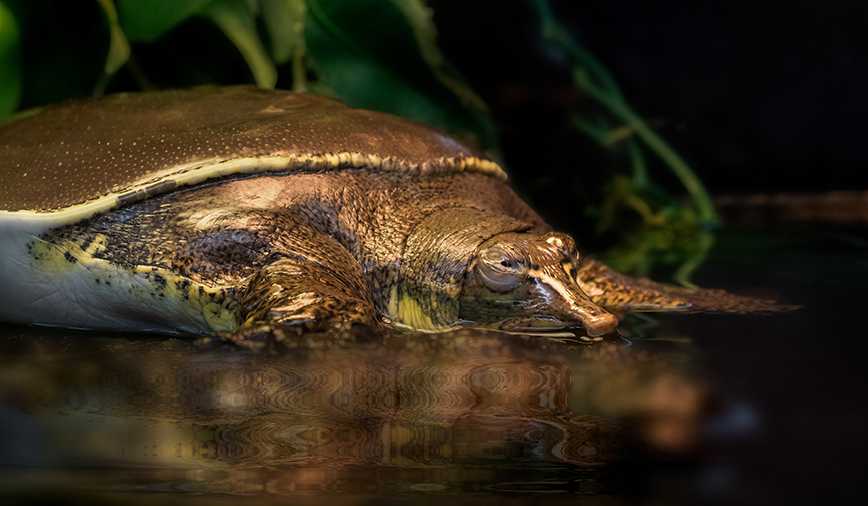Pam’s Perspective
Pam Otto is the Manager of Nature Programs and Interpretive Services for the St. Charles Park District
Remember the old Celozzi-Ettleson car commercial tag line, “Hard to find, tough to beat”? That slogan well-described the car dealership which, as I remember, was near Roosevelt Road in Elmhurst. But it also makes an apt description for one of my favorite critters, the spiny softshell turtle.
Every bit as abundant as our more commonly seen species, the painted turtle and snapper, spiny softshells are harder to find simply because of their secretive ways. They bask on rocks and logs, but startle quickly and will slip back into the water sometimes before you even notice they’re there.
As their name implies, softies lack the hard shells that characterize our other native species. Instead of scaly scutes, their bony bodies are covered with leathery skin. This lack of scales may seem like a disadvantage, but the softshell’s quick reflexes and even quicker impulse to bite leave them well protected from harm.
Softshells also have an amazing ability to disappear right before your eyes. Sitting on the stream bottom, they twist and dig into the soft substrate until their bodies submerge, so that sometimes even their pointy snouts disappear into the muck.
I don’t know if any of you have ever tried burying yourself in muck (I did, just once, a very long time ago) but even just imagining it you might realize that there’s a potential problem. How do you breathe down there?
As reptiles, spiny softshells have lungs and breathe air just like we do. But, they have an advantage we humans can only dream about: They can absorb oxygen through specially adapted cells in the pharyngeal lining (of the throat) and cloacal lining (of, yep, the other end) as well as in the skin. This adaptation helps not only when hunting or hiding underwater, but also during hibernation; in our climate, spiny softshells may stay buried underwater for six months out of the year.
When you take a look at a spiny softshell, you might find yourself thinking, “Okay, I see where the name softshell comes from. But what about the ‘spiny’ part?”
That’s when it’s time for even closer examination. There actually are two places to look for spiny details. One is inside the turtle’s nose. (I did say closer…) Each side of the rostrum (the “divider” in the middle of the nose) has a pointy, spine-like projection. Some folks say this is where the species gets its name.
But there’s another spiny feature more likely responsible for the turtle’s name. Along the anterior, or front, edge of the turtle’s carapace, or top “shell,” lie a series of bumps called tubercles. Present as small nubs on juveniles, these tubercles become more prominent and pointy as the turtle ages, and are particularly noticeable on females.
Speaking of the ladies, if you do happen upon some turtles basking and notice some that are really—and I mean really—large, those are female softshells. They can grow to a length of 15 inches or more. With their flat, round, brownish carapaces glinting in the light, they look for all the world like giant pancakes laying there soaking up some sun.
Male softies are smaller, measuring up to nine inches. In addition, males tend to retain the more colorful spotted carapace pattern seen in juvenile spiny softshells, while females turn a muddy, blotchy brown.
(Continued on Page 2)
Pam’s Perspective – Page 2
If spiny softshells are on your list of things to see this spring, choose a sunny, warm day and head for the Fox River. One pretty reliable place to see them is on the rocks in the river by the Geneva water treatment plant, just north of Fabyan Forest Preserve. I also see them fairly regularly in the water by the Pottawatomie Golf Course in St. Charles.
Or, if you want a sure thing, wait just another few weeks. On Saturday, April 30th, from 1 to 4 p.m., we will host the grand opening or our new Hickory Knolls Discovery Center. We’ll offer a wide number of exhibits and live animal displays—including a large aquarium that is home to Tortuga, a young spiny softshell donated last year.
Located at the western edge of the James O. Breen Community Park, at the southwest corner of Peck and Campton Hills Roads in St. Charles, the facility might, like the softshells, at first seem hard to find. But once you’re here you’ll see we’re also tough to beat. See you there!
Pam Otto is the manager of nature programs and interpretive services for the St. Charles Park District. She can be reached at 630-513-4346 or potto@stcparks.org.

